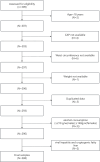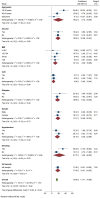Association Between Weight-Adjusted Waist Circumference Index and Metabolic Disease-Associated Fatty Liver Disease: A Retrospective Study
- PMID: 40671693
- PMCID: PMC12266079
- DOI: 10.2147/RMHP.S524872
Association Between Weight-Adjusted Waist Circumference Index and Metabolic Disease-Associated Fatty Liver Disease: A Retrospective Study
Abstract
Background: Metabolic disease-associated fatty liver disease has brought significant challenges to public health and social-economics. There is a need for a straightforward and effective method to screen for metabolic disease-associated fatty liver disease. The weight-adjusted waist circumference index offers a comprehensive reflection of visceral fat accumulation and skeletal muscle loss. This study aims to explore the relationship between weight-adjusted waist circumference index and hepatic steatosis and hepatic fibrosis.
Methods: This single-centered study screened 288 participants from the outpatient department of the Affiliated Hospital of Hangzhou Normal University (Hangzhou, China). Multiple linear regression models were utilized to assess the association between weight-adjusted waist circumference index and hepatic steatosis and hepatic fibrosis. The subgroup analysis was carried out according to sex, smoking, drinking, BMI, cardiovascular disease, diabetes and hypertension.
Results: Metabolic disease-associated fatty liver disease was diagnosed in 185 out of 288 patients. Multivariate linear regression analysis indicated a positive linear correlation between weight-adjusted waist circumference index and hepatic steatosis and hepatic fibrosis (P < 0.05). Analysis of subgroups revealed a stronger positive correlation between weight-adjusted waist circumference index and controlled attenuation parameter among participants aged 18-59 years and smokers (P < 0.05). Positive correlations between weight-adjusted waist circumference index and hepatic fibrosis were observed in participants who were alcohol consumers, male, had a body mass index of >28, and with diabetes (P < 0.05).
Conclusion: We report a significant linear positive correlation between weight-adjusted waist circumference index and metabolic disease-associated fatty liver disease, suggesting that weight-adjusted waist circumference index is a potential indicator for metabolic disease-associated fatty liver disease screening.
Keywords: abdominal obesity; cross-sectional study; hepatic fibrosis; hepatic steatosis; metabolic-associated fatty liver disease; weight-adjusted waist index.
© 2025 Tang et al.
Conflict of interest statement
The authors declare that they have no competing interests in this work.
Figures
References
LinkOut - more resources
Full Text Sources




